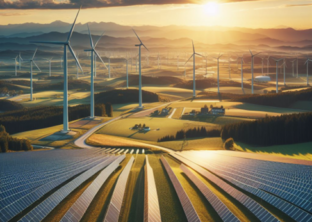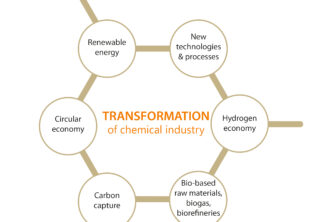Sustainability or the long way to green chemistry
If we want to create a fully green and fossil fuel-free chemistry, to be honest, we still have a long way to go. However, the first steps have already been made. At the moment efforts are concentrating on:
- Reducing the share of fossil energy and non-renewable raw materials.
- Making use of post-consumer waste – mainly packaging, by sorting and recycling some plastic types.
But if we want to create a 100 percent circular economy, that will not be enough.

Whereas energy supply might be substituted by renewable sources, mainly wind, water and photovoltaics, raw material upstream cannot be substituted that easily as this will require new synthesis routes, starting from:
- Alternative but renewable sources, e.g. timber wood, straw or other plant sources.
- Recycled materials.
Let us have a look at Status Quo of Recycling
If we think of the recycling of packaging materials, only few are fully reused in the same way they were first used. All materials below belong to a group that have a high share of recycling in the Western World, based on postconsumer sorting and collection schemes.

But what about the tons of laminated materials consisting of 5, 7 or 9 layers of different plastic materials, or coated material and composites used as construction parts in the engineering, automotive industry, in healthcare and other industries? How can they be recycled beyond energetic recycling/incineration which is at the moment the most frequently used method? Other types of recycling already exist but are used to a lesser extent.
Types of recycling

Circular economy – example polymers

Established Processes for Plastic Recycling
Solvent-based Purification (SBP)
Solvent-based processes allow the recycling of currently non-recyclable plastic compounds.
This type of recycling method uses a selective solvent dissolution process to remove impurities from postindustrial and postconsumer plastic, thereby recovering plastics of suitable quality for reuse.
The clean polymer can be recovered from the solution by precipitation.
There are several processes that have been developed based on solvent-based recycling of plastic waste.
- Proctor & Gamble’s PureCycleTM Process uses a solvent dissolution process to recover virgin-like recycled polypropylene (PP).
- APK AG’s Newcycling® Process recycles multilayer plastics to yield polymers with properties close to virgin materials.
- Fraunhofer’s CreaSolv® Process selectively dissolves targeted polymer from plastic waste, removing contaminants and precipitating the resulting polymer fraction.
- Polystyvert uses a solvent to dissolve waste polystyrene (PS), filtering out contaminants from the PS solution and then recrystallizing the polymer.
- Sulzer’s DEVO process can be used, for example, for postconsumer textile waste recycling.
Pyrolysis
Chemical recycling of plastics is gaining mainstream attention due to its potential to convert plastics into hydrocarbon building blocks, e.g.
- Naphtha
- Diesel
- Aromatics
- Waxes
Pyrolysis occurs at high temperatures (500° C) and in the absence of oxygen. Due to the nature of the waste feedstock plastics, pyrolysis oil contains impurities such as Sulphur, Nitrogen, Chlorine, oxygenates, which need to be removed before the pyrolysis oil can be utilized in downstream processes.
After purification high-quality hydrocarbon feedstock can be obtained that can be used to create new polymers also for food applications that require highly pure materials. Thermal pyrolysis is typically used for the recycling of those polymers for which depolymerization is harsh and that are not currently mechanically recyclable (PE/PP/PS mixtures, multilayer packaging, and reinforced fibers).
Solvolysis
Solvolysis involves the breaking of the hydrolysable bonds of a polymer in the presence
of an alcohol or water, e.g.
- In the recycling of PET, recovery of different monomers such as MEG, BHET, TPA or DMT can be achieved by solvolysis at high purity.
- Different methods and synthesis routes have been developed depending on the desired end product.

- In the recycling of Polystyrene, recovery of high-purity Styrene from recycled PS, even from highly contaminated feedstocks, can be achieved.
The next steps
Using the full set of available recycling methods and process will help to
- Increase the recycling rates of materials that are not yet recycled at all.
- Lower the rate of energetic recycling /incineration.
- Bring us closer to circular chemistry.

Anja Fürbach, Market Intelligence Senior Expert
Sources:
- https://www.careelite.de/kunststoff-recycling/;
- https://www.verpackungsregister.org/fileadmin/Auswertungen/ZSVR_Recycling-rates_2018_2020_EN.pdf;
- https://www.hunold-knoop.de/kunststoff-blog/kunststoff-recycling-3-methoden/;
- Angewandte Chemie Volume59, Issue36, September 1, 2020, Pages 15402-15423;
- Materials 2021, 14(17), 4782;
- https://doi.org/10.3390/ma14174782;
- https://onlinelibrary.wiley.com/doi/10.1002/anie.201915651;
- https://www.mdpi.com/1996-1944/14/17/4782/htm;
- https://www.spglobal.com/commodityinsights/en/ci/products/solvent-based-recycling-of-waste-plastics-199H.html;
- https://www.sulzer.com/en/shared/applications/solvent-based-recycling;
- https://www.mdpi.com/1996-1944/14/17/4782/htm, https://onlinelibrary.wiley.com/doi/10.1002/anie.201915651.







